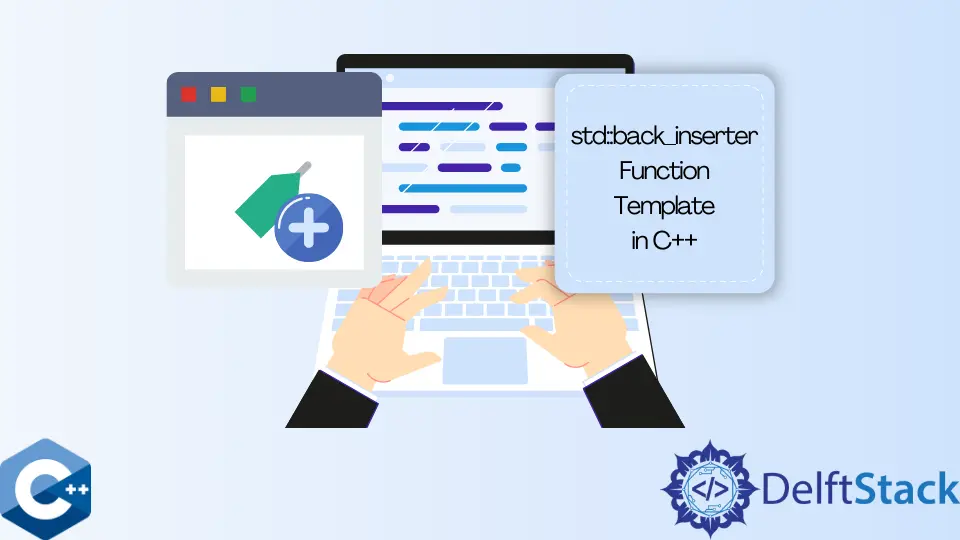The std::back_inserter Function Template in C++

The C++ Standard Library offers a plethora of tools to make programming easier and more efficient. One such tool is the std::back_inserter function template, which is a part of the <iterator> header. This handy utility allows you to insert elements at the end of a container, effectively enabling dynamic growth of the container. Whether you are working with vectors, lists, or other containers, std::back_inserter can streamline your code and enhance its readability.
In this article, we will explore how to effectively use std::back_inserter in various contexts, providing you with practical examples and insights to improve your C++ programming skills.
Understanding std::back_inserter
The std::back_inserter function template is a powerful utility that creates an output iterator. This iterator can be used to add elements to the end of a container. It’s particularly useful when you want to insert multiple elements into a container using algorithms from the Standard Template Library (STL), such as std::copy or std::transform.
To use std::back_inserter, you need to include the <iterator> header file. The syntax is straightforward:
std::back_inserter(container)
Here, container is the STL container (like std::vector or std::list) where you want to insert elements. The iterator created by std::back_inserter knows how to insert elements at the end of the specified container.
Example of Using std::back_inserter
Let’s take a look at a simple example that demonstrates how to use std::back_inserter. In this case, we will copy elements from one vector to another.
#include <iostream>
#include <vector>
#include <algorithm>
#include <iterator>
int main() {
std::vector<int> source = {1, 2, 3, 4, 5};
std::vector<int> destination;
std::copy(source.begin(), source.end(), std::back_inserter(destination));
for (const auto& elem : destination) {
std::cout << elem << " ";
}
return 0;
}
Output:
1 2 3 4 5
In this example, we first create a source vector containing integers. We then create an empty destination vector. Using std::copy along with std::back_inserter, we copy all elements from the source vector to the destination vector. The std::back_inserter automatically handles adding elements to the end of the destination vector, making the code clean and efficient.
Advantages of Using std::back_inserter
There are several advantages to using std::back_inserter in your C++ programs. First and foremost, it simplifies the syntax needed for inserting elements into a container. Rather than manually managing the size and capacity of the container, std::back_inserter abstracts this complexity away, allowing you to focus on your algorithm.
Additionally, using std::back_inserter can enhance performance. When you insert elements directly into a container, the container may need to resize itself to accommodate new elements. By using std::back_inserter, you allow the container to manage its own growth, which can lead to fewer reallocations and better performance in many cases.
Lastly, std::back_inserter promotes cleaner and more maintainable code. It encourages the use of STL algorithms, which are often more readable than manual loops. This leads to code that is easier to understand and maintain over time.
Example of Transforming Elements with std::back_inserter
Another common use case for std::back_inserter is transforming elements before inserting them into a container. For instance, you might want to square each element from one vector and insert the results into another vector. Here’s how you can achieve that:
#include <iostream>
#include <vector>
#include <algorithm>
#include <iterator>
int main() {
std::vector<int> numbers = {1, 2, 3, 4, 5};
std::vector<int> squares;
std::transform(numbers.begin(), numbers.end(), std::back_inserter(squares), [](int n) { return n * n; });
for (const auto& square : squares) {
std::cout << square << " ";
}
return 0;
}
Output:
1 4 9 16 25
In this example, we have a vector of integers called numbers. We then create an empty vector called squares. Using std::transform, we apply a lambda function that squares each number and inserts the result into the squares vector via std::back_inserter. This demonstrates the flexibility and power of std::back_inserter in transforming data efficiently.
Conclusion
The std::back_inserter function template is an invaluable tool in the C++ programmer’s toolkit. It simplifies the process of inserting elements into containers, promotes cleaner code, and can lead to performance improvements. By using std::back_inserter in conjunction with STL algorithms like std::copy and std::transform, you can write more efficient and maintainable C++ code. Whether you are a beginner or an experienced developer, mastering std::back_inserter will undoubtedly enhance your programming skills.
FAQ
-
What is the purpose of std::back_inserter?
std::back_inserter is used to create an output iterator that allows you to insert elements at the end of a container. -
Which header file do I need to include for std::back_inserter?
You need to include the<iterator>header file. -
Can I use std::back_inserter with any container type?
Yes, std::back_inserter can be used with any STL container that supports the push_back method, such as vectors and lists. -
How does std::back_inserter improve performance?
It abstracts the complexity of managing container size, allowing the container to handle its own growth, which can reduce reallocations. -
Is std::back_inserter suitable for large data sets?
Yes, it is suitable for large data sets, as it efficiently manages memory allocation and insertion.
Founder of DelftStack.com. Jinku has worked in the robotics and automotive industries for over 8 years. He sharpened his coding skills when he needed to do the automatic testing, data collection from remote servers and report creation from the endurance test. He is from an electrical/electronics engineering background but has expanded his interest to embedded electronics, embedded programming and front-/back-end programming.
LinkedIn Facebook